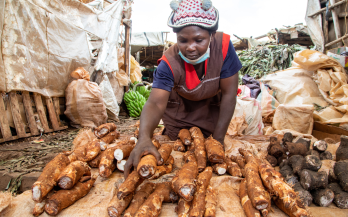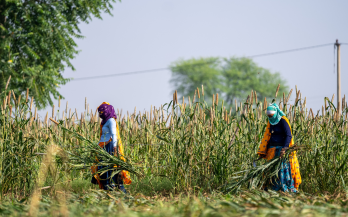Poor diets are the leading cause of global ill health, resulting in malnutrition and deficiencies such as anaemia, decreased energy levels, diminished health, and decreased productivity. A diverse diet containing a wide variety of food types is more likely to provide the vitamins and minerals needed for good health, to boost brain and body development, and bolster resistance to infections. However, in 2021, more than 3.1 billion people in the world—or 42 percent of the global population—were unable to afford a healthy diet. Tea workers and farmers, predominantly women, often contend with high rates of malnutrition due to diets lacking essential nutrients. Healthy Diets for Tea Communities is a public-private collaboration between the Global Alliance for Improved Nutrition (GAIN), the Ethical Tea Partnership (ETP), and eight leading tea companies, which aims to promote healthy diets in tea supply chains in India, Malawi, and Kenya. This document summarises programme results in Kenya.
Global tea production totals over USD 17 billion annually, and the sector continues to grow. In many countries, the tea sector contributes significantly to income and employment for millions of rural families, with smallholder farmers producing 60 percent of world production. However, tea workers and farmers often suffer from high malnutrition rates because their diets, which consist largely of staple foods such as rice, bread, maize, and wheat, often lack foods rich in essential nutrients and vitamins needed for good health. Nutritious foods are often less affordable and available to this population, and they may be less aware of the importance of healthy diets. In Assam State, one of the main tea-producing states in India, 18 percent of women are underweight, 66 percent of women are anaemic, and 15 percent of women are overweight.
Poor diets are the leading cause of global ill health, resulting in malnutrition and deficiencies such as anaemia, decreased energy levels, diminished health, and decreased productivity. A diverse diet containing a wide variety of food types is more likely to provide the vitamins and minerals needed for good health, to boost brain and body development, and bolster resistance to infections. However, in 2021, more than 3.1 billion people in the world—or 42 percent of the global population—were unable to afford a healthy diet. Tea workers and farmers, predominantly women, often contend with high rates of malnutrition due to diets lacking essential nutrients. Healthy Diets for Tea Communities is a public-private collaboration between the Global Alliance for Improved Nutrition (GAIN), the Ethical Tea Partnership (ETP), and eight leading tea companies, which aims to promote healthy diets in tea supply chains in India, Malawi, and Kenya. This document summarises programme results in Malawi between 2020 and 2023.
In 2021, more than 3.1 billion people in the world – or 42 per cent of the global population – were unable to afford a healthy diet. Tea workers and farmers, predominantly women, often contend with high rates of malnutrition due to diets lacking essential nutrients. Healthy Diets for Tea Communities is a public-private collaboration between the Global Alliance for Improved Nutrition, the Ethical Tea Partnership and eight leading tea companies which aims to promote healthy diets in tea supply chains in India, Malawi, and Kenya. Between 2020 and 2023, the programme reached 734,075 people, increasing the percentage of women in the programme eating minimally diverse, nutritious diets – 5 out of 10 food groups – in all three countries. The documents below summarise the programme’s impact in Assam, Kenya and Malawi.
The youth leadership initiative is a platform for young individuals aged 18-25 to actively participate in food systems decision-making. This initiative aims to provide opportunities for young people to have a voice and influence in the decisions that shape food systems, especially national food systems pathways.
The youth leadership initiative is a platform for young individuals aged 18-25 to actively participate in food systems decision-making. This initiative aims to provide opportunities for young people to have a voice and influence in the decisions that shape food systems, especially national food systems pathways.
This facilitator handbook is a key resource in this process, offering structured support and inspiration. The handbook provides you with suggested plans and sessions but is designed to be used flexibly, with each facilitator selecting the most relevant exercises for them and adding their own content and expertise, and on the group, context, time and mode of delivery you have available. Activities in this guide are suitable for groups of 20 - 30 young people and can be delivered both online an in person.
The purpose of this assessment tool is to gather data from vendors, consumers, and key stakeholders in traditional markets to identify food safety challenges and perceptions. This information helps design effective behaviour change interventions to enhance food safety practices. The tool includes methods for comprehensive data collection through interviews, observations, and discussions.
This report demonstrates that investing in nutritious food value chains allows investors to achieve significant gender impact. The hope is that more funding will be unlocked for nutritious food value chains, particularly for small and medium enterprises (SMEs), which critically lack access to financing in emerging markets.
Environmental factors impact human health and nutrition through various pathways, and these impacts can be felt disproportionately by already vulnerable groups like women and children.










